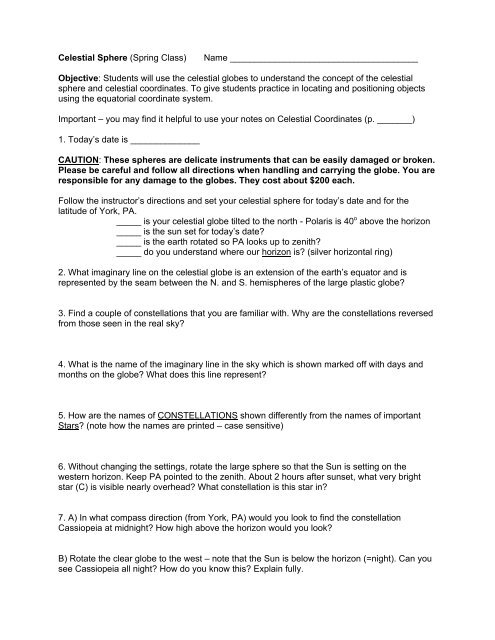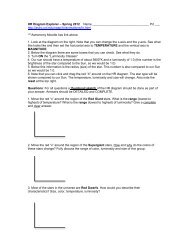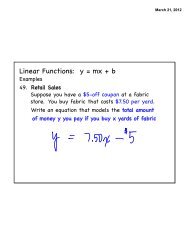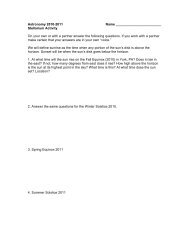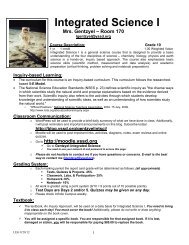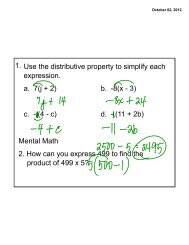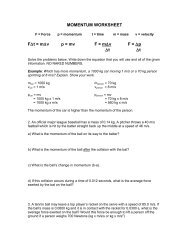celestial sphere activity
celestial sphere activity
celestial sphere activity
Create successful ePaper yourself
Turn your PDF publications into a flip-book with our unique Google optimized e-Paper software.
Celestial Sphere (Spring Class)<br />
Name ______________________________________<br />
Objective: Students will use the <strong>celestial</strong> globes to understand the concept of the <strong>celestial</strong><br />
<strong>sphere</strong> and <strong>celestial</strong> coordinates. To give students practice in locating and positioning objects<br />
using the equatorial coordinate system.<br />
Important – you may find it helpful to use your notes on Celestial Coordinates (p. _______)<br />
1. Today’s date is ______________<br />
CAUTION: These <strong>sphere</strong>s are delicate instruments that can be easily damaged or broken.<br />
Please be careful and follow all directions when handling and carrying the globe. You are<br />
responsible for any damage to the globes. They cost about $200 each.<br />
Follow the instructor’s directions and set your <strong>celestial</strong> <strong>sphere</strong> for today’s date and for the<br />
latitude of York, PA.<br />
_____ is your <strong>celestial</strong> globe tilted to the north - Polaris is 40 o above the horizon<br />
_____ is the sun set for today’s date?<br />
_____ is the earth rotated so PA looks up to zenith?<br />
_____ do you understand where our horizon is? (silver horizontal ring)<br />
2. What imaginary line on the <strong>celestial</strong> globe is an extension of the earth’s equator and is<br />
represented by the seam between the N. and S. hemi<strong>sphere</strong>s of the large plastic globe?<br />
3. Find a couple of constellations that you are familiar with. Why are the constellations reversed<br />
from those seen in the real sky?<br />
4. What is the name of the imaginary line in the sky which is shown marked off with days and<br />
months on the globe? What does this line represent?<br />
5. How are the names of CONSTELLATIONS shown differently from the names of important<br />
Stars? (note how the names are printed – case sensitive)<br />
6. Without changing the settings, rotate the large <strong>sphere</strong> so that the Sun is setting on the<br />
western horizon. Keep PA pointed to the zenith. About 2 hours after sunset, what very bright<br />
star (C) is visible nearly overhead? What constellation is this star in?<br />
7. A) In what compass direction (from York, PA) would you look to find the constellation<br />
Cassiopeia at midnight? How high above the horizon would you look?<br />
B) Rotate the clear globe to the west – note that the Sun is below the horizon (=night). Can you<br />
see Cassiopeia all night? How do you know this? Explain fully.
Make sure you know what lines and numbers are DECLINATION and which ones are<br />
RIGHT ASCENSION. In items 8-12, identify the object that is located at the given<br />
equatorial coordinates. Dec.= Declination, NOT December :>). Note that some of the<br />
declinations are positive and some are negative ( - ).<br />
8. R.A. 6 h 40 m / Dec. -17 o Object ______________________<br />
9. R.A. 14 h 15 m / Dec. 19 o Object ______________________<br />
10. R.A. 5 h 50 m / Dec. 7 o Object ______________________<br />
11. R.A. 3 h 40 m / Dec. 23 o Object ______________________<br />
12. R.A. 16 h 25 m / Dec. -24 o Object ______________________<br />
In items 13-18, state the equatorial coordinates of the following stars/objects: note how<br />
RA and declination are stated above.<br />
13. Procyon R.A. __________ Dec. ______________ (in Canis Minor)<br />
14. Altair R.A. __________ Dec. ______________<br />
15. Spica R.A. __________ Dec. ______________ (in Virgo)<br />
16. Rigel R.A. __________ Dec. ______________ (in Orion)<br />
17. The Sun R.A. __________ Dec. ______________ (on today’s date)<br />
18. M31 R.A. __________ Dec. ______________<br />
19. Why can’t we see the stars of the constellation Capricorn on this date?<br />
20. There are a number of stars and constellation we will never see from York, PA. Rotate the<br />
<strong>celestial</strong> globe and notice that there are stars and constellations that NEVER rise above the<br />
horizon (can you find the constellation called the Crux also known as the Southern Cross?).<br />
They all are located at declination minus _______ degrees and higher. What is the R.A and<br />
Declination of the Southern Cross (Crux)?<br />
21. The second brightest star in the sky is Canopus at R.A 6h, 30m / Dec. -53 o . Can you see it<br />
from York? Why or why not?<br />
22. See the instructions in #1. Set the <strong>celestial</strong> globe for Mexico City (latitude 20 o ). Could you<br />
see the Southern Cross from here? Where would you look? (direction and height or angle above<br />
the horizon).<br />
23. Set the globe for the North Pole (today’s date) and describe the path the stars travel. Where<br />
is the sun? What is it like at the North Pole this time of year?


